Apple's 2010 MacBook Air (11 & 13 inch) Thoroughly Reviewed
by Anand Lal Shimpi on October 26, 2010 10:08 PM EST- Posted in
- Mac
- Apple
- MacBook Air
- Laptops
The SSD: Not Half Bad
Apple advertises the new MacBook Air as being instant on as a result of the internal SSD. That’s mostly untrue. From a completely powered off state the MacBook Air still takes time to boot. That time is significantly reduced compared to the old MacBook Air and any other Mac with a conventional hard drive. It’s even a shorter boot than my MacBook Pro with a SandForce SF-1200 based SSD in it:
| System Performance Comparison | ||||||
| Boot | Shut Down | Sleep | Awake | |||
| 11-inch MacBook Air | 15.5 seconds | 2.2 seconds | 1.0 second | 1.63 seconds | ||
| 13-inch MacBook Air | 14.4 seconds | 1.9 seconds | 1.0 second | 1.56 seconds | ||
| 13-inch MacBook Air (Late 2008) | 34.4 seconds | 2.9 seconds | 1.6 seconds | 4.19 seconds | ||
| 15-inch MacBook Pro (SF-1200 SSD) | 19.1 seconds | 1.8 seconds | 1.5 seconds | 2.3 seconds | ||
| 15-inch MacBook Pro (Mid 2009, HDD) | 34.2 seconds | 2.8 seconds | 1.8 seconds | 2.1 seconds | ||
You'll notice that even the SF-1200 SSD in my 15-inch MacBook Pro takes longer to boot than these new Airs. Apple does customize the firmware on its SSDs. I’d be willing to bet the SSD in the MacBook Air has tight integration with OS X to guarantee quicker than normal boot times.
Clearly the new Air isn't instant on from a boot standpoint, but it's pretty much there from a recover-from-sleep standpoint. The new Airs both go to sleep and wake up from sleep quicker than any of the other Macs, including my upgraded 15-inch Core i7 MacBook Pro. Again, nothing can trump Apple's tight integration between hardware and software.
Apple likes to work with two different controller manufacturers for SSDs: Samsung and Toshiba. iFixit already confirmed Toshiba is in the new MacBook Air with its teardown:
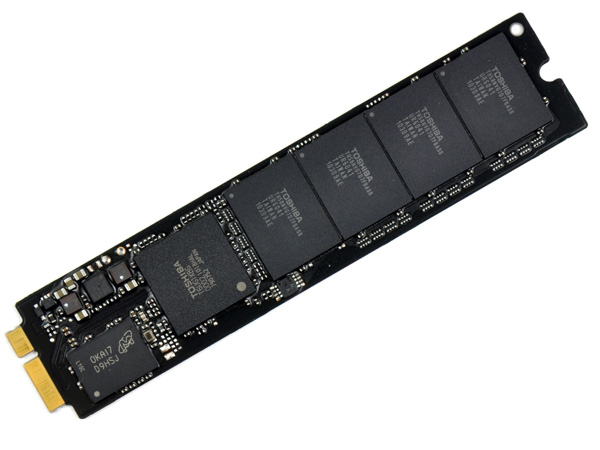
The 11-inch MacBook Air SSD, courtesy of iFixit
The SSD isn’t in an industry standard form factor, although the connector appears to be either micro or mini SATA. Presumably 3rd party SSD manufacturers (ahem, SandForce partners I’m looking at you) could produce drop in replacements for the MacBook Air SSD.
There’s nothing particularly innovative about the form factor of the SSD, other than Apple did away with the unnecessary space a 2.5” SSD would require. Just as SSDs will break the traditional SATA interface barriers, we’ll see the same happen to form factors as well.
The part number on the Toshiba controller may look familiar to some of you. It’s the same controller that’s in Kingston’s SSDNow V+ Series and the SSDNow V Series Boot Drive. I reviewed the latter not too long ago and found that it was a good drive for the money, and here’s the kicker: the SSDNow V Series Boot Drive was amazingly resilient when written to without TRIM support. Its performance hardly dropped as a result of normal desktop use. This is very important because although OS X 10.6.4 has a field for reporting TRIM support on an SSD, the instruction isn’t actually supported by the OS. Even the new MacBook Airs don’t ship with a version of OS X with TRIM support.
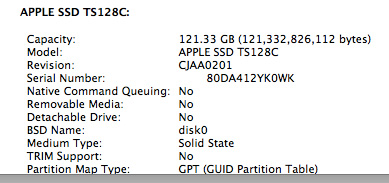
The SSD only has four NAND devices on it. Typically that would mean some very low transfer speeds, particularly on writes. But each one of those four devices has at least 16GB of NAND, spread across multiple planes and die. With the right firmware, you should be able to extract a good deal of parallelism from this architecture. Apple and Toshiba apparently do just that.

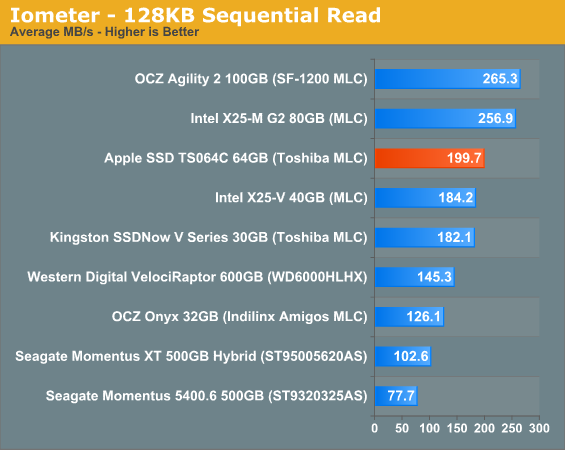
While most value SSDs top out at under 100MB/s, we get nearly 200MB/s sequential reads and writes out of the SSD in the new MacBook Air. And fortunately, Apple hasn’t only focused on sequential performance. The random read/write performance of the new MacBook Air SSD isn’t terrible:
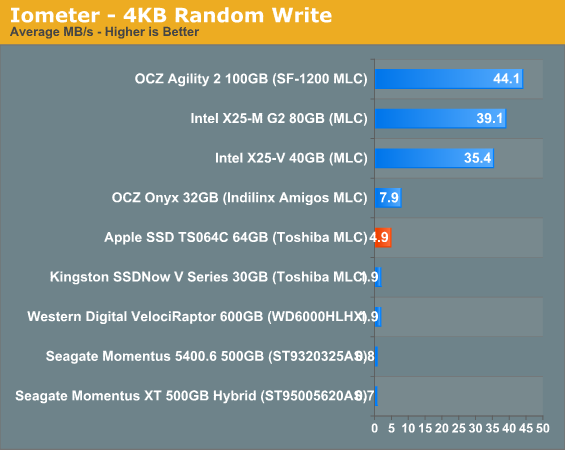
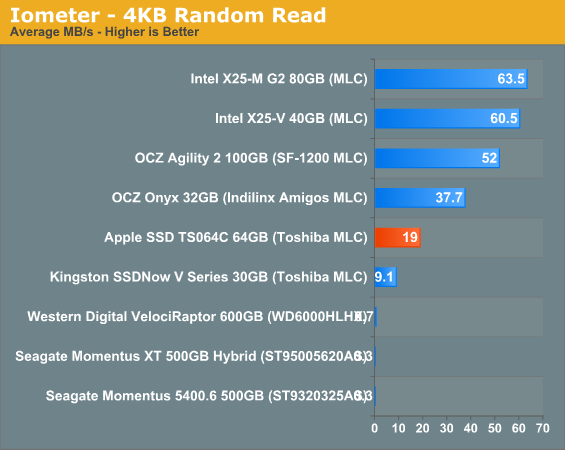
Random write performance is of course the weak point, but you’ll notice that it’s actually higher than the Kingston drive that uses the same controller. While Apple would’ve been better off striking a deal with Intel or SandForce for the controller in the MacBook Air, the Toshiba controller isn’t horrible.
As I mentioned earlier, resilience is very important as OS X still doesn’t support TRIM. I filled the drive with garbage and then tortured it for 20 minutes with random writes. The resulting performance drop was noticeable, but not unbearable:
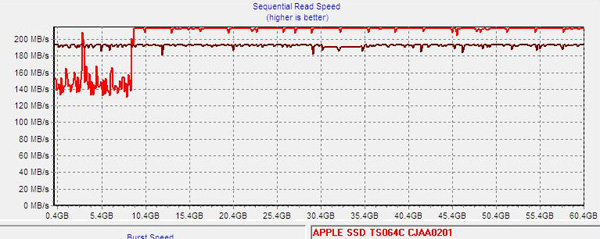
A single pass of sequential writes restores performance to normal:
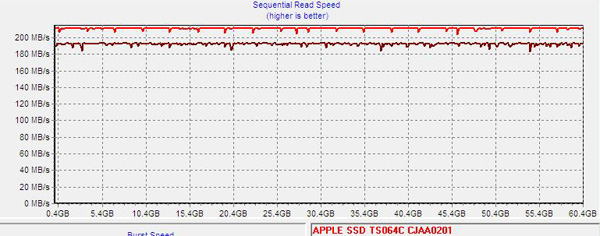
This tells us two things. First, through normal use the drive should be able to recover its performance over time (assuming you give it enough spare area). And second, if there’s any idle garbage collection in Apple’s custom firmware for the Toshiba controller it should be able to keep the drive running at peak performance even without TRIM supported in the OS. I don’t have a good way of measuring whether or not there’s GC enabled on the drive in OS X, but I suspect Apple is (at least it appears to be doing so on the Mac Pro’s SSDs).
Overall I’m pleased with Apple’s SSD selection. It could’ve been a lot better but it could’ve been a lot worse. The MacBook Airs in their default configuration have better IO performance than any other standard config Mac sold on the market today, including the Mac Pro.










185 Comments
View All Comments
deslock - Thursday, October 28, 2010 - link
Thanks Anand & Vivek for the detailed and interesting review. I hope you post a followup with more info on how Apple was able to get this level of performance out of the hardware (vs other similar SSD-equipped machines). Also I'd like to see a long term test of performance (because of the lack of TRIM), or perhaps additional testing showing just how effective the new MBAs are with GC.Oscarcharliezulu - Thursday, October 28, 2010 - link
Thanks for a great, detailed review that doesn't gloss over any point. I've read as many reviews as I can find and many gloss over or just take things as a given - not much more useful than the Apple web site. Your review was detailed in all the right areas. I know where I will be disappointed and where I will be happy. No surprises thanks to your review.I think for a business user (web + mail + Word processing + presentations + lightweight spreadsheet) the Air's may be pretty good - finally great battery life (with wifi active) so I can go out to a customer and work off battery all day without carrying an extra battery or carrying the AC adapter.
Pity about the price - once you tick the options the price becomes ridiculous when you compare to mainstream laptops. I will have to stick to a base model + 4GB ram, and wait to upgrade the SSD later (someone is sure to come up with an upgrade).
And graphics - for ultraportables its good, but the higher end pro's etc really need a lot more grunt - we should be able to play games at High at native resolution.
pmeinl - Friday, October 29, 2010 - link
Just stumbled across an SSD 256GB upgrade kit for the 11.6":http://www.photofast.tw/products/GM2_SFV1_Air.html
It includes an USB adapter for using the orginal SSD as portable storage.
mutatio - Friday, October 29, 2010 - link
Anyone else hear this thing screaming for Fusion in it? If AMD can finally get their power specs in line to be competitive with intel the 11" would be one smoking little monster if Apple bites at it. :-)63jax - Friday, October 29, 2010 - link
don't hurry to change your mac's, just wait for AMD to release their Fuzion chips and then we will have the perfect Mac's. i know i will...Norrah - Saturday, October 30, 2010 - link
I would really like to see how an older Macbook Air (rev c) with an aftermarket SSD would hold up against the new.. performance wise!I need the last kick, if i am to go for the new.
jorjitop - Saturday, October 30, 2010 - link
I think that there is another factor you missed which makes a difference to the relative performances. That is, the 11 inch has a 800 Mhz front bus, while the 13 inch has a 1066 Mhz front bus. In my experience, this makes a noticeable difference to performance.Brooklynzoned - Saturday, October 30, 2010 - link
Both models are 2010, Both machines are running Window's 7. Both Machines Score a 5.3 out of 7Apple Macbook Pro with a 2.4 8G Ram with a Seagate XT Hybrid....Scored 5.3
Apple Macbook Air with a 2.13 4G Ram with the 256 SSD Flash......Scored 5.3
Dell Adamo Onyx With a 1.4 4G Ram with a 128SSD .....................Scored 3.2
Funny thing is the Macbook Pro has a video card with 256 dedicated memory
the macbook air has shared video memory.... and scored higher in the 3D
Brooklynzoned - Saturday, October 30, 2010 - link
Battery Life Amazing,Speed,, Oh Yeah this baby moves.... N quick.. Faster then my Macbook Pro
its crazy how fast it starts up... not from sleep but from a full shutdown and startup. Fast...
The Macbook Air is The future of what a Notebook Should be.
ioannis - Sunday, October 31, 2010 - link
Anand,on page "The 13", the captions at the top seem to suggest that you are comparing the 13" MBA with 15" MBP, while the text suggests otherwise (13" MBA vs 13" MBP, which makes more sense).
thanks